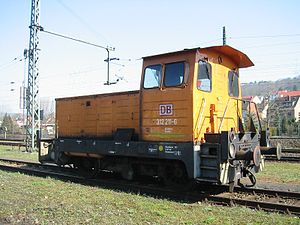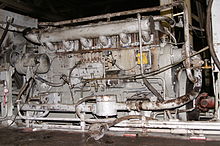DR series 102.1
| DR series 102.1 | |
|---|---|
|
Locomotive 312 211 of the former Eisenach depot (2003, Eisenach)
|
|
| Numbering: | DR: 102 101 to 102 257 DB AG: 312 101 to 312 257 |
| Manufacturer: | LKM Babelsberg |
| Year of construction (s): | 1970-1971 |
| Retirement: | from 1992 |
| Axis formula : | B. |
| Gauge : | 1435 mm ( standard gauge ) |
| Length over buffers: | 8000 mm |
| Height: | 3695 mm |
| Width: | 3000 mm |
| Total wheelbase: | 3560 mm |
| Empty mass: | 24.3 t |
| Wheel set mass : | 12.2 t |
| Top speed: | 40 km / h |
| Hourly output : | 162 kW / 220 PS |
| Continuous tensile force: | 71 kN |
| Wheel diameter: | 1000 mm |
| Motor type: | 6 VD 18 / 15-1 SRW 1 |
| Drive: | diesel-hydraulic |
| Brake: | Train brake: indirectly acting K-brake, direct acting additional brake, handbrake on all axles |
| Train control : | Sifa |
The vehicles of the series 102.1 of the Deutsche Reichsbahn were light two-axle shunting diesel locomotives with rod drive .
development
As part of its new building program, the Deutsche Reichsbahn intended to procure a new, small diesel-hydraulic locomotive for light line, handover and shunting services . This locomotive was supposed to replace the widespread and mostly worn out small locomotives Kö and Köf. The DR first developed the 101.0 to 101.7 series . In terms of performance and running technology, these machines abandoned the design principle of small locomotives. The locomotives performed well and were popular with the staff. Nevertheless, while retaining the vehicle part, a more powerful engine and a modified transmission were installed, creating the DR series 102.0 .
As a result of close cooperation between the Deutsche Reichsbahn and LKM Babelsberg , a completely new traction vehicle was created in 1970, in which the tried and tested drive technology of the 102.0 series was adopted. The experience gained with the 101/102 series and the requirements of the client were taken into account. With a wheelbase of 3560 mm, a smooth top speed of 40 km / h was possible. The starting tractive effort of 71 kN now allows heavy units to be maneuvered.
construction
The sturdy, completely welded sheet metal inner frame was made of 20 mm thick sheet metal in order to withstand the typical loads that occur during shunting. The upper end is a frame cover plate with openings for the diesel engine and gearbox as well as indentations at the frame ends for spacious maneuvering steps. The vehicle frame is supported by leaf springs on the two slide-mounted wheel sets. The normal UIC pulling and pushing devices were initially installed on the stiffened end walls. Appropriate mounting shafts were provided for the later installation of a central buffer coupling .
The front section houses the cooler , diesel engine , transfer case , three-cylinder air compressor , fuel tank, oil bath air filter and exhaust silencer . Air tanks, sand and battery boxes are installed on the right and left below the walk-in circulation.
A 6 VD 18 / 15-1 SRW 1 diesel engine from VEB Elbewerk Roßlau is used to generate power . As a six-cylinder Vorkammerreihenmotor without charging makes it 220 hp (162 kW) at 1,510 min -1 . As can be seen from the type designation, the cylinders have a bore of 150 mm and a stroke of 180 mm. The built-in diesel engine is a cold starter , but could also be electrically preheated or kept warm when external electrical energy was fed in from the local network. The operating conditions of the engine such as oil pressure and temperatures were monitored electrically. Exceeding the setpoints led to the engine being switched off automatically.
The power flow from the engine initially takes place via a torsionally flexible coupling and a short cardan shaft to the boosting of the fluid transmission GSU 20 / 4.5 with starting converter (up to 16 km / h) and marching converter (for 16–40 km / h). The gearbox is switched automatically depending on the driving speed. The reversing gear , which enables the direction of travel to be changed, is flanged directly to the fluid transmission .
The jackshaft is driven directly by the reversing gear and transmits the torque to the two gear sets via coupling rods .
A transfer case is installed on the diesel engine, which drives the radiator fan and the air compressor via a belt drive and electrically switchable multi-plate clutches . The clutches are switched according to the operating conditions of the cooling water temperature and tank pressure.
The locomotives have an automatic single-chamber compressed air brake, type Knorr, with a driver's brake valve Fbs 14 that can be operated from both sides of the driver's cab, and a non-automatic, direct-acting auxiliary brake with auxiliary brake valves . The two sets of wheels are braked from the front on one side. The mechanical handbrake acts on the mechanics of the compressed air brake via a linkage.
The locomotives have a 24 V electrical power supply from a three-phase alternator with rectifier or from lead-acid batteries . The diesel engine is started electrically with a 15 HP starter . All locomotives are equipped with a safety driving circuit and, in addition to shunting radio , some are also equipped with train radio .
During the last repairs carried out by Deutsche Bahn, all reconditioned locomotives were given oil sumps under the engine, gearbox and axle box bearings.
Individual machines were still equipped with the RK 900 automatic shunting coupling .
commitment
All 157 locomotives were delivered to the DR and could be found in the entire network. The locomotives, which the staff referred to as letterboxes , gazebos or footstools , proved themselves just as well as their predecessors. These locomotives can still be found today mainly in the areas of wagon management and vehicle maintenance or in construction train operations. In the meantime, almost the entire inventory has been scrapped or sold to other operators by DB. While the class 102.1 locomotives were only employed by the DR before the rail reform , these robust shunters can still be found today on some industrial railways and railway associations in Germany and even in Switzerland .
literature
- Wolfgang Glatte: Diesel Locomotive Archive . Transpress, Berlin 1986, ISBN 3-344-00061-6
- Deutsche Reichsbahn: DV 931, Th.26, description, operating and maintenance instructions for the diesel traction vehicle series 102.1 . Berlin 08/1970
Web links
- The DR series 102.1 at deutsche-kleinloks.de




